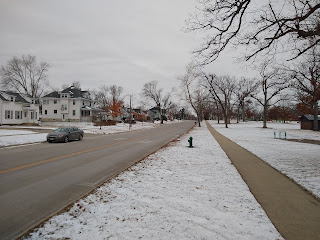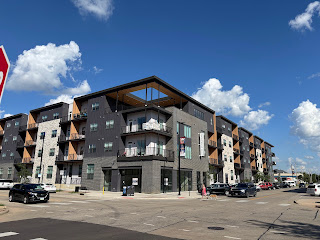Should this intersection be a roundabout?
 |
| (Google Earth screen capture) |
The four-way stop at Forest Drive and Cottage Grove Avenue,
right by Washington High School on the southeast side of Cedar Rapids, has
twice had roundabout proposals rejected. A third bite at that apple is therefore unlikely, but is
that a good thing? Anyway, roundabouts are the pumpkin spice of the street
design world right now, with strong feelings on both sides, and therefore we must have an opinion. Might as well be
an informed one.
We can move the conversation along a little by noting roundabouts are likely to be useful (if still controversial) in some places and not useful in others. A roundabout at the intersection of U.S. 30 and State Route 1 outside of Mt. Vernon untangled a problematic intersection. Commonly-cited advantages of roundabouts compared with traffic lights are they move vehicle traffic more efficiently while lowering their maximum speed (a win-win!), with fewer injuries, cost less, and aren't subject to power outages. Strong Towns (2018) notes that “roundabouts can even out traffic flow compared to typical signalized intersections which tend to create stop-and-go lineups of cars. But whether they can relieve truly congestion depends on what is causing it…” The "Mythbusters" show even found roundabouts moved traffic better than four-way stops (see Ihnen 2013, Gursten 2014).
Forest and Cottage Grove are in town, about two miles from the city center. Cottage Grove had an average daily traffic count of 5800 in 2017. (Forest Drive’s count hasn’t appeared on the map since at least 2009.) The main traffic issues, though, occur at the beginning and end of the school day, so roughly 7:30-8 a.m. and 2:30-3 p.m.
The location of the high school at that intersection means that we’re anticipating cyclists and pedestrians as well. Here the Internet is frankly not encouraging. For cyclists, the Iowa Department of Transportation advises:
Bicyclists have a legal
right to ride on most roadways just like motorized traffic. Roundabouts are
just like other intersections in that bicyclists may either follow the rules of
the road and maintain travel on the roadway or use available paths and crosswalks
to safely bypass the roundabout.
The New York Department of Transportation adds these tips:
1.
If you are comfortable riding in traffic, take the lane and
circulate like you are a vehicle, making sure you yield to traffic in the
circle when entering.
2.
Ride at the speed of the circular roadway to discourage cars
from passing you.
3.
When you exit the roundabout, use your right hand signal.
4.
If you are uncomfortable riding through the roundabout, dismount
and walk your bike as a pedestrian at the designated crosswalks.
But it’s one thing to have “a legal right,” it’s quite
another to feel safe exercising it. Indeed, a
2021 review of 49 studies mostly from Europe found:
Crash data and observations suggest that when
cyclists “take the lane” and operate as vehicles – as is allowed or even
recommended in some current design guidelines – this leads to conflicts and
crashes between circulating cyclists and entering drivers who may have “looked
but failed to see” (and thus failed to yield to) the cyclist.
They conclude that discretion is the better part of
valor.
Providing separated cycle paths around the
roundabout seems to be a lower-risk and more comfortable design solution,
although care must be taken to encourage appropriate yielding at crossings.
This makes sense, though a series of intersections at
which diversion is required is going to get frustrating, resulting in either
more aggressive cycling or no cycling at all, neither of which are outcomes we
should desire.
Satisfactory solutions for pedestrians are also
elusive. The Iowa Department of Transportation recommends:
Pedestrians should always
use the crosswalks; and make sure the vehicle operators see him/her before
entering the crosswalk.
This seems reasonable enough, but this video from Minnesota-based
traffic engineers Stonebrooke…
…shows that we are expecting pedestrians to wander out of their way to find the crosswalk, and expecting vehicle drivers to stop for them when they ask to cross. We are expecting strollers to go straight while we push them with one arm while holding the other one out for all to see, and we are expecting we will not feel silly doing that. Good luck, with all of that.
Strong Towns
(2016) allows “a roundabout can provide good, safe crossing opportunities
for pedestrians, but only if engineers have pedestrians and bicyclists in mind when
they design the roundabout…” This means (1) single-lane roundabouts not
multi-lane, (2) not having pedestrians cross lanes with “particularly heavy”
exiting volumes, (3) maintaining clear sight lines for drivers, (4) locating
crosswalks away from the circle itself, (5) pedestrians signals to accommodate
blind pedestrians, and (6) beaucoup public education.
They also note all this works “only if drivers use them
properly.”
For this reason, Jeff Speck (Walkable City Rules, Island Press, 2018) wants roundabouts out
of urban areas.
There are a number of features that make roundabouts feel less walkable than traditional intersections.
- First, they ask people who are trying to walk in a straight line to divert well to the side, and then back again, in order to keep moving across town.
- Second, while they require cars to slow and yield to pedestrians, vehicles never actually come to a full stop unless something is blocking them; roundabouts feel dynamic, and pedestrians prefer environments that are static.
- Third, they introduce into urban areas a design vocabulary which is unavoidably automotive; they swoop. (2018: 164-165, bullets added)
But our intersection isn't in an urban downtown, it's two miles away by a high school. Traffic is heavy for half an hour to an hour on school mornings and afternoons, and light the rest of the day. I think the roundabout might be highly functional 22-23 hours a day: drivers on either street could proceed without having to come to a full stop, and pedestrians might be glad to have them out of the way quicker.
It's those brief periods when traffic through this intersection is heaviest that give me pause. Moreover, it's heavy with inexperienced drivers taking themselves to school. Not many people walk to the high school; as Cedar Rapids schools get bigger and more spread out, fewer students walk. However, because of where the stop is located, city bus riders must also cross both streets to get to the school. As confusing as four-way stops can be, would people on foot be more confident getting across the street if cars were not coming to full stops?
We can hope for more pedestrian and cyclist traffic in the future. Just because the area isn't urbanized now, there's no reason that it should never be, given its proximity to the city center and development on 1st Avenue. A federal Safe Routes to School grant was recently used to build a wide sidewalk through this very intersection that coincidentally links the Interurban and CeMar trails. Does, or could, this encourage more walking and cycling, at all times of day?
Bottom line: There would be certain advantages to putting a roundabout here, but its effect on pedestrian and cyclist behavior now and particularly in the future tells me we shouldn't do it.
Where Should We Build Roundabouts?
- 1st Avenue and Collins Road E
- Council Street and Collins Road NE
- 16th Avenue and Williams Boulevard SW
- Edgewood Road and Williams Boulevard SW
- Edgewood Road and Blairs Ferry Road NE
- probably a lot more, but these would be towards the top!
SEE ALSO: "When Are Roundabouts Indicated?" 2 August 2018
Kai Ryssdal and Nicholas Guiang, "Don't Panic, It's Just a Roundabout," Marketplace, 22 December 2022
Extreme roundabouting: (I am absolutely not recommending this!!)













